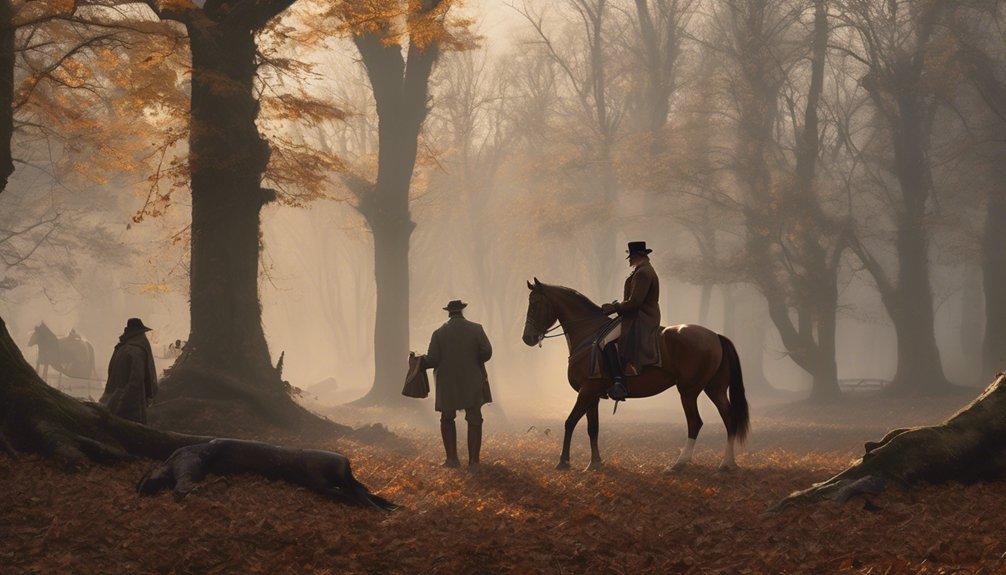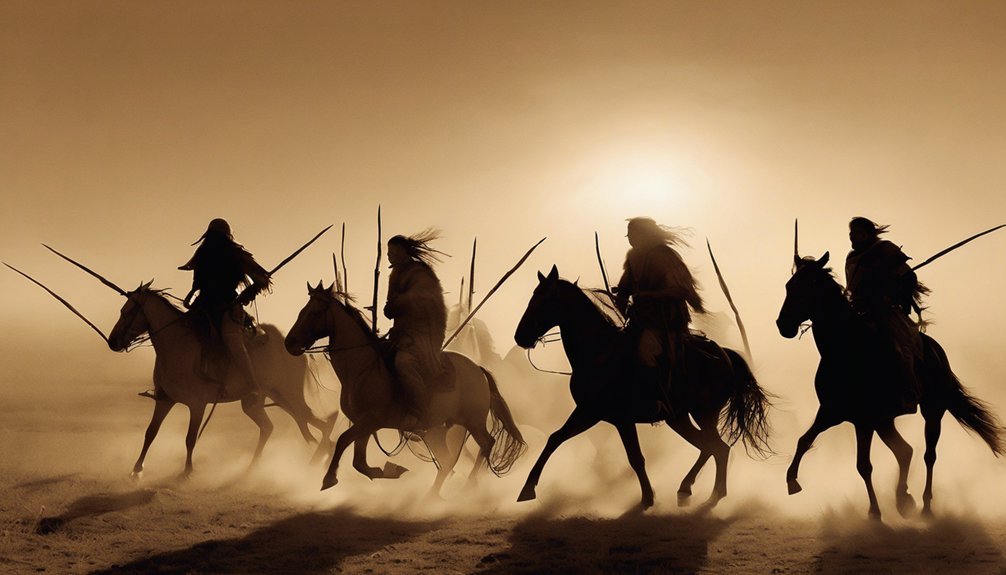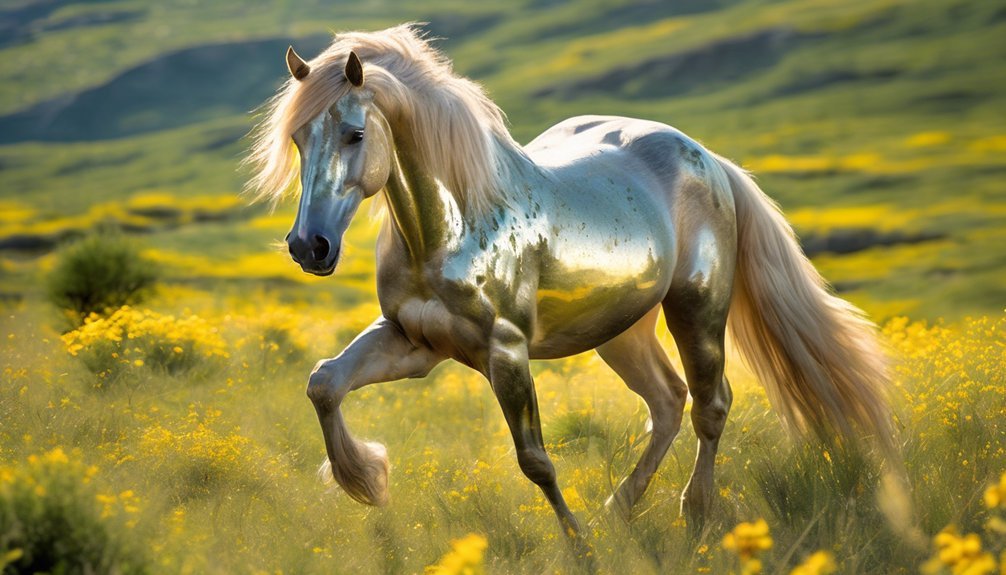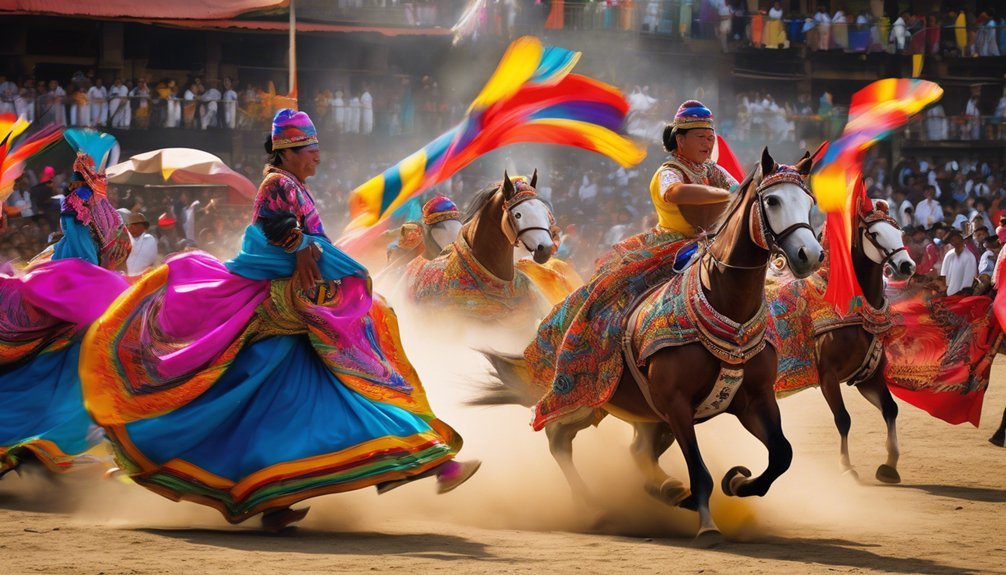
Imagine the thundering hooves of horses echoing across ancient plains, their riders poised for the hunt. This partnership transformed hunting from a solitary pursuit into a dynamic interplay of speed and strategy. As you explore the historical significance of horses in hunting, consider how this bond not only shaped techniques but also influenced cultural identities. What unfolds is a complex narrative of power, tradition, and ethical considerations that continue to resonate today.
Key Takeaways
- Horses revolutionized hunting by enhancing mobility and efficiency, allowing hunters to pursue prey over vast terrains more effectively.
- In ancient civilizations, horses symbolized status and power, intertwining hunting practices with social dynamics and showcasing knights' skills during elaborate tournaments.
- Indigenous cultures adapted hunting techniques by utilizing horses for stealth, deepening their connection to the land and transforming hunting into a cultural practice.
- Modern hunting retains the legacy of horses, emphasizing their role in maintaining hunting ethics and enhancing the overall experience through horseback riding.
- Mastery of horseback riding improves hunting proficiency, fostering patience, strategy, and a deeper respect for wildlife through the hunter-horse partnership.
The Early Relationship Between Humans and Horses in Hunting

As humans began to harness the strength and speed of horses, their relationship evolved dramatically, transforming hunting practices across various cultures.
The early domestication of horses marked a pivotal shift; you found partners in these magnificent creatures, enhancing mobility and efficiency during hunts.
These hunting partnerships allowed for greater range and speed, enabling you to pursue game more effectively.
This collaboration wasn't merely about practicality—it deepened bonds between species, intertwining your lives in ways that shaped social structures and survival tactics.
As you began to rely on horses, you experienced a profound sense of connection, recognizing them not just as tools but as vital allies, enriching your hunting experiences and reflecting the beginnings of a remarkable journey together.
Horses in Ancient Civilizations: A Hunting Advantage
In ancient civilizations, horses revolutionized hunting by providing unmatched mobility and speed, allowing hunters to traverse vast landscapes quickly.
This dynamic partnership not only increased the range of hunting territories but also enhanced various techniques, such as pursuing game over rough terrain.
As you explore this topic, consider how these advantages shaped hunting strategies and ultimately influenced the survival of these societies.
Mobility and Speed
Although ancient civilizations relied heavily on various hunting techniques, the introduction of horses revolutionized their approach, providing unparalleled mobility and speed.
With the advent of horseback riding, hunters could traverse vast landscapes swiftly, tracking game over long distances with ease. This newfound agility allowed them to adapt their hunting strategies, engaging prey in ways previously unimaginable.
The ability to close in on herds or evade dangerous animals transformed the dynamics of their pursuits. As you imagine these ancient hunters galloping across open fields, it's clear that horses offered more than just transportation; they became invaluable partners in the hunt.
Their speed and endurance enabled civilizations to thrive, forever changing the relationship between humans and the natural world.
Hunting Techniques Enhancement
While hunting techniques evolved significantly with the introduction of horses, the true advantage lay in how these animals transformed the very methods used by ancient civilizations.
Horses didn't just add speed; they reshaped hunting strategies in profound ways.
- Increased Range: You could now cover vast territories, expanding your hunting grounds.
- Improved Coordination: Equestrian skills allowed for more intricate group tactics, enhancing teamwork.
- Enhanced Stealth: Mounted hunters could approach prey silently, leveraging the horse's natural movement.
- Access to New Prey: Horses enabled you to pursue faster creatures that were once out of reach.
These innovations didn't just change how you hunted; they deepened the bond between horse and rider, creating a legacy still felt today.
The Rise of Knightly Hunting Traditions
As the medieval period unfolded, knightly hunting traditions emerged not merely as a pastime but as a vital expression of status and power.
You'd find that these pursuits weren't just about the thrill of the chase; they were tightly woven into the fabric of feudal society. Knights engaged in elaborate hunting tournaments, showcasing their skills and valor.
These events were crucial for building alliances and demonstrating wealth, as the spoils of the hunt often reflected a knight's prestige. The rituals surrounding these hunts, from the choice of horse to the selection of hounds, emphasized the connection between nobility and mastery over nature.
In this context, hunting became a vivid tableau of knightly traditions, merging sport, strategy, and social hierarchy.
Indigenous Cultures and the Use of Horses in Stealth Hunts
In many Indigenous cultures, the domestication of horses revolutionized hunting practices, allowing for more efficient stealth techniques.
You'll find that these cultures adapted their strategies to leverage the horse's speed and agility, enhancing their ability to approach prey unnoticed.
Moreover, horses hold deep cultural significance, symbolizing not just a means of transportation but also a vital connection to the land and its resources.
Historical Horse Domestication
Although many cultures have relied on horses for various purposes, Indigenous peoples uniquely harnessed their capabilities for stealth hunting, transforming the dynamics of their relationship with the environment.
Understanding horse origins and the domestication timeline reveals how these connections developed.
Consider the following aspects:
- Adaptability: Horses adapted to diverse landscapes, allowing Indigenous hunters to navigate various terrains.
- Communication: A strong bond formed between horse and rider, enhancing silent communication during hunts.
- Mobility: Horses provided unparalleled speed and agility, crucial for tracking game.
- Cultural Significance: Horses became symbols of status and power, deepening their integration into spiritual and practical aspects of Indigenous life.
Stealth Hunting Techniques
While many hunting techniques rely on brute force or sheer numbers, Indigenous cultures have mastered the art of stealth hunting using horses, creating a symbiotic relationship that enhances their effectiveness in the field.
You'll find they employ stealth tactics that hinge on horse concealment, allowing them to navigate the terrain undetected. By blending with the landscape, they minimize noise and movement, ensuring they remain hidden from their prey.
This approach not only showcases their deep understanding of animal behavior but also highlights the horse's role as a silent partner in the hunt. The ability to remain unseen transforms the hunt into a dance between hunter and hunted, where patience and precision become paramount, ultimately leading to a more sustainable and respectful relationship with nature.
Cultural Significance of Horses
Horses hold profound cultural significance in Indigenous societies, particularly in the context of stealth hunting where their partnership extends beyond mere utility. They embody a rich tapestry of cultural symbolism and equestrian heritage that resonates deeply within these communities.
Consider these aspects of this relationship:
- Spiritual Connection: Horses are often seen as spiritual guides, enhancing the hunter's intuition.
- Community Bonding: The act of hunting together fosters a sense of unity and shared purpose.
- Cultural Storytelling: Legends and stories about horses enrich the cultural narrative, passing wisdom across generations.
- Sustainable Practices: Using horses in stealth hunts exemplifies a harmonious relationship with nature, emphasizing respect and balance.
In these ways, horses aren't just tools; they're integral to the identity and survival of Indigenous cultures.
The Evolution of Hunting Techniques With Equine Companions

As hunting evolved from a necessity for survival to a sport and cultural practice, the incorporation of equine companions transformed the dynamics of the chase.
You might notice how horses enhanced your mobility, allowing you to cover vast territories and track prey more effectively. This equine evolution not only expanded hunting practices but also deepened your connection with the land.
With each gallop, you could feel the pulse of nature, heightening your awareness of the environment. The partnership between hunter and horse became a dance of instinct and skill, where teamwork was essential.
As techniques advanced, so did your understanding of animal behavior, enriching the experience. Ultimately, this synergy fostered a bond that transcended mere utility, creating a shared journey through history.
Modern Hunting Practices: The Legacy of Horses
Although many modern hunting practices have evolved with technology, the legacy of horses remains deeply embedded in the culture and strategies of hunting today.
Horses not only enhance your experience but also uphold important hunting ethics. Consider how they influence your practice:
- Mobility: Horses allow you to cover larger areas, increasing your chances of a successful hunt.
- Tradition: Equestrian sports are woven into hunting culture, reminding you of its rich history.
- Connection: Riding fosters a deeper bond with nature, enhancing your appreciation for wildlife.
- Skill Development: Mastering horseback riding improves your overall hunting skills, blending two disciplines seamlessly.
Embracing this legacy enriches your hunting journey, maintaining a vital connection to the past while navigating modern practices.
Frequently Asked Questions
How Did Horses Impact Hunting Strategies in Different Climates?
Horses enhance your hunting efficiency by adapting strategies to various climates. In colder regions, they help you traverse snow; in arid areas, they provide mobility, both crucial for tracking prey and ensuring successful hunts.
What Breeds Were Historically Favored for Hunting Purposes?
Historically, about 80% of hunters preferred thoroughbred hunters for their speed, while foxhound breeds excelled in stamina. You'd find these horses and hounds working together, forming a powerful duo in the pursuit of game.
Did Horses Affect the Types of Prey Hunted?
Horses significantly influenced prey availability and hunting efficiency. Their speed and endurance allowed you to pursue various game types, shaping hunting strategies and enabling access to previously unreachable prey, thus altering your choices in the hunt.
How Did the Use of Horses Vary by Region?
You'll notice that horses' use varies greatly by region, reflecting cultural significance and regional techniques. In some areas, they enhance speed and efficiency, while in others, they symbolize status or tradition, shaping hunting practices uniquely.
What Are the Ethical Considerations of Using Horses in Modern Hunting?
When it comes to modern hunting, you've got to tread carefully. Balancing animal welfare with hunting regulations is crucial. Ensuring horses are treated ethically isn't just right; it's a reflection of your values as a hunter.
Conclusion
Throughout history, horses have galloped alongside hunters, weaving an intricate tapestry of cultural significance and practical advantage. Their presence transformed the chase, turning vast landscapes into fields of opportunity. As you reflect on this bond, consider how these noble creatures continue to shape modern hunting practices, reminding us of our connection to nature and the ethical responsibilities that come with it. Just as a river carves its path through stone, the legacy of horses remains etched in the art of hunting.





